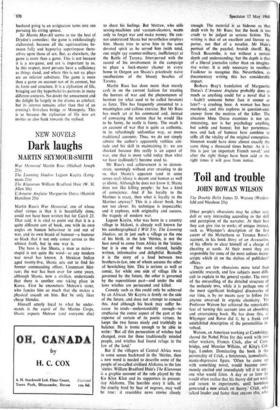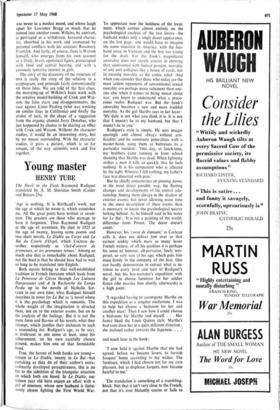Toil and trouble
JOHN ROWAN WILSON
The Double Helix James D. Watson (Weiden- feld and Nicolson 35s) Other people's obsessions may be either very dull or very interesting according to the skill and perception of the narrator. At their best they can give rise to works of unique interest, such as Whymper's description of the first ascent of the Matterhorn or Terence Reese's account, in his book Story of an Accusation, of his efforts to clear himself of a charge of cheating at cards. At their worst they are responsible for some of the most tedious Manu- scripts which sit on the shelves of publishers' offices.
There are few obsessions more total than scientific research, and few subjects more diffi- cult to explain to the general reader. The story of the unravelling of the detailed structure of the molecule DNA, while it is perhaps one of the most significant biological discoveries of our time, is by no means easy to follow for anyone unversed in organic chemistry. Yet Professor Watson has achieved the remarkable feat of turning this account into an absorbing and entertaining book. He has done this, as Whymper and Reese did it, by a frank and uninhibited description of the personalities in- volved.
Watson, an American working at Cambridge, shared the Nobel Prize for this work with two other workers, Francis Crick, also of Cam- bridge, and Maurice Wilkins, of King's Col- lege, London. Dominating the book is the personality of Crick, a boisterous, iconoclastic, manic-depressive figure. 'Often he came up with something novel, would become enor- mously excited and immediately tell it to any- one who would listen. A day or so later he would often realise that his theory did not work and return to experiments, until boredom generated a new attack on theory.' Crick, who talked louder and faster than anyone else, who was never in a modest mood, and whose laugh upset Sir Lawrence Bragg so much that he moved into another room. Wilkins, by contrast, is portrayed as a withdrawn, harassed charac- ter, absorbed in his work and tormented by personal conflicts with his assistant Rosemary Franklin. And lastly, of course, there is Watson himself, who emerges from his own account as a lively, brash, egotistical figure, preoccupied with food and central heating, and with a curiously tentative interest in girls.
The story of the discovery of the structure of DNA is really the story of the solution to a cryptogram, and proceeds fairly conventionally on these lines. We are told of the first clues, the marrying-up of Wilkins's basic work with the creative model-building of Crick and Wat- son, the false starts and disappointments, the race against Linus Pauling (who was working on similar lines in California) and finally the stroke of luck, in the shape of a suggestion from the organic chemist Jerry Donahue, who just happened by chance to be sharing an office with Crick and Watson. Without the character studies, it would be an interesting story, but by no means outstanding. With the character studies, it gives a picture, which is so far unique, of the way scientists work and live together.







































 Previous page
Previous page